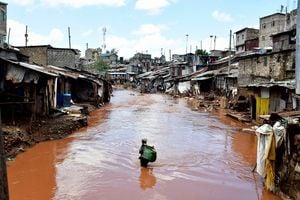
Ethiopian Prime Minister Abiy Ahmed. He suggested that the lack of access to a Red Sea port was a potential source of future conflict with its neighbours.
| File | AFPOur Columnists
Premium
Give family coastal land, please
A few days ago, Ethiopia’s Prime Minister Abiy Ahmed suggested that lack of access to a Red Sea port was a potential source of future conflict with its neighbours.
With an estimated population of 127 million, Ethiopia is the world's most populous landlocked country.
It lost its access to the sea in 1993, when Eritrea gained independence after a three-decade war, and its main trade route now runs along roads and a railway that links the capital Addis Ababa to Djibouti port. Lately, it also trades through its Moyale border point to the Mombasa port in Kenya.
“It is crucial for the present leaders of Somalia, Djibouti, Eritrea and Ethiopia to engage in discussions, not just for the present, but to ensure lasting peace,” PM Abiy said in a televised speech.
Of Africa’s 55 countries, 16 are landlocked: Botswana, Burkina Faso, Burundi, Central African Republic, Chad, Ethiopia, Lesotho, Malawi, Mali, Niger, Rwanda, South Sudan, Swaziland, Uganda, Zambia and Zimbabwe. Uganda, with 48 million people, is the second-most populous landlocked country on the continent.
Abiy’s assessment of landlockedness being potentially a source of conflict is on the money. Based on nominal gross domestic product (GDP), Ethiopia’s economy is the fifth-largest in Africa. It is Africa’s second-most populous country after Nigeria.
The combined populations of its coastal neighbours Djibouti, Eritrea and Somalia are about 23 million; that is equal to the population of Ethiopia’s Amhara region and far shy of the 40 million in Oromia.
There is a historical inevitability about it. At one time, for a country with a population and economy the size of Ethiopia's, it will no longer be tenable for it to continually negotiate for port access from smaller neighbours. It could seize land and cut a path to the sea.
By 2050, Ethiopia’s population is projected to be 205 million. At that point, it can afford to send lose five million citizens carrying sticks and stones fighting their way through Djibouti or Eritrea to carve a path to a port site.
Uganda doesn’t enjoy such a menacing advantage against coastal neighbours Kenya and Tanzania.
However, the deep political elite divisions in Kenya, and its fraught elections, present opportunities that, if it were sufficiently Machiavellian, Uganda could exploit in future (after dealing with its own President-Yoweri-Museveni-for-life handicap).
Removing barriers
But there is a cheaper way Ethiopia and Uganda can gain greater sea access without using soldiers. Expanding and removing all barriers to free trade and the movement of goods will solve a large part of the problem.
The next step could be to give or sell landlocked countries a piece of land at the coast to build their own ports or logistic hubs.
The sweetener would be to grant these zones tax-free status or mark them as diplomatic areas where the authority of Kenya, in the case of Uganda, would be minimal. That, however, might just be a bridge too far.
For what would Kenya get out of it? Perhaps it could get an inland port near Uganda’s border with South Sudan or the Democratic Republic of Congo that enjoys the same tax-free status.
In Ethiopia’s case, the land area between it and Djibouti and Eritrea is small. The two countries can cede it territory which gives it a strip to the coast, in exchange for the equivalent piece of Ethiopian land.
Land is an unreasonably emotive issue, so we can fully expect that that wouldn’t happen without a big fight from the people currently occupying the lands that would be traded.
The next best option is one that has been on the table for a while—political federation. East African Federation has been touted for over 10 years but it has gone nowhere.
Uganda's President Yoweri Museveni, its biggest champion, has been one of its liabilities. Kenyans, in particular, break out in a massive cold sweat when they think of living under his less-than-benign-no-term-limit rule were he to be the federation president.
However, this is the most promising path because it also solves the access problem for countries further inland, like Burundi and Rwanda.
It also means that the question of Ethiopia and Somalia joining the East African Community (EAC) assumes a new strategic imperative—and that means one can’t leave Djibouti and Eritrea out of the conversation. Somalia is already on its way into the EAC.
And early this month, EAC Secretary-General Peter Mathuki made comments that were seized upon by integration fundamentalists to suggest that Ethiopia and Djibouti were also set to join the bloc.
Were all these states to join into an East African federation, it would become one of the largest ‘countries’.
But with the chaos and madness in some of these countries already, the prospect of such a federation is scary. It would be ungovernable.
However, that might well be its benefit. Without a single dictator imposing their will or a suffocating state lording it over citizens and getting in the way, the people of the federation would create magic.
- Mr Onyango-Obbo is a journalist, writer and curator of the "Wall of Great Africans". @cobbo3





